This site is made possible
by its sponsors. Please visit them!
cool colors - Colors are often described as having temperature — as warm (reds, oranges, and yellows) or cool (greens, blues, and violets). Cool colors are often associated with water, sky, spring, and foliage, and suggest cool temperatures. They appear on one side of the color wheel, and opposite the warm colors. Psychologically, cool colors are said to be calming, unemphatic, depressive; and optically, they generally appear to recede.
Purple (red-violet) and yellow-green are between warm and cool. Don't call them "neutral," because neutral colors are grays, whites, and blacks. Meteorologists discuss the middling temperatures much more than than color theorists do. Following the lead of the weather-folk, if the color is as in-between warm and cool as it could possibly be, the most solid word is "temperate." "Mild" leans slightly more toward warm than toward cool — this would be appropriate for a certain yellow that is somewhat green, or a certain red that is somewhat violet, but not for the utterly in-between colors.Other words are problematic in other ways, often for suggesting value judgments, and those would (or might) be unwanted. ArtPage generally avoids prescriptive judgments, preferring to report patterns in art speakers' and writers' behaviors. Nevertheless, if we had to choose a word for the colors that are absolutely balanced between warm and cool, temperate is that bon mot. Contact to report what word you use, or someone uses for in-between-warm-and-cool colors.
Also see analogous colors, chroma, complementary colors, earth colors, hue, shade, and tint.
cooperative learning - Typically, small-group learning activities that promote positive interaction resulting in improved learning. The teacher divides a class into groups of two to six, each group containing a mix of student types — backgrounds, achievement levels, social skills, etc. — with each member responsible for making specific contributions to the success of the group. Research shows that more students become more successful in school when this method is used. While developing students' social skills, cooperative learning promotes psychological well-being — students gain greater acceptance and freedom, that they are having fun, surviving more securely, and even acquiring power. High-achieving, low-achieving, special education and at-risk students benefit academically. As students' attitudes improve, they become more highly motivated and productive. The teacher plays an active role in monitoring and supervising student groups, helping them function and complete assignments. Individual student progress is measured by individual assessments. Group progress is measured by group success in accomplishing the group's goal. Although excellence in art disciplines is certainly dependent on the efforts of individuals, that excellence is less likely to thrive in a competitive environment than in a cooperative one. Historically, the most successful cultures have been those which interacted and worked together most harmoniously.
co-opt - To absorb, assimilate, or appropriate. As an example, it seems ever more difficult for any movement to be avant-garde, considering how rapidly they are co-opted by the institutions of the artworld and mainstream culture.
copal - A resin made from fossil trees, used as a varnish and in paint media.
coping - A method of splitting away stone from a block preliminary to shaping a carving. Small punch are driven into a block and hit in sequence until the stone splits between them.
copper resinate - A particular green pigment.
Related resource:
Coptic art - Art of the early Christians of Egypt from the fourth to the eighth centuries CE, during the end of the Roman period and the beginning of the Byzantine period. Under Rome, Fayum burial portraits done in encaustic are the great achievement. Coptic style changed greatly under the influence of Byzantium, becoming flat and stylized. Coptic influences can be seen in later Ethiopian art.
Examples:

Coptic Egypt, Fragment: Personification of Luna, the Moon,
or Head of Diana, Goddess of the Hunt, late 3rd or early
4th century CE,
22 1/32 x 24 4/5 inches (56 x 63 cm), Metropolitan Museum of
Art, NY. See fragment and
textile.

Coptic Egypt, Panel, 3rd century CE,
linen and wool, 8 2/3 x 13
3/8 inches (22 x 34 cm), Metropolitan Museum of Art, NY. "In
this panel, perhaps from a ritual or festival garment, Dionysos
in his chariot, bearing grapes aloft, triumphantly celebrates
his conquest of India. While a part of the popular Dionysian
cycle, this episode in particular had also been embedded in Egyptian
ruler mythology since Alexander."
Coptic Egypt, Fragment of a Rug, 40 5/32 x 46 1/16 inches (102 x 117 cm), Metropolitan Museum of Art, NY.

Coptic Egypt, Tunic with Dionysiac Ornament, 4-5th
century CE,
72 1/32 x 53 5/32 inches (183 x 135 cm), Metropolitan Museum
of Art, NY. See costume.
Coptic Egypt, Wall Hanging with Mounted Riders Hunting, 400-499, linen and wool, 40 15/16 x 24 4/5 inches (104 x 63 cm), Metropolitan Museum of Art, NY.

Ethiopia, Lake Tana region, Illuminated Gospel, early 15th century,
vellum, wood, tempera,
ink, height
16 1/2 inches (41.9 cm), Metropolitan Museum of Art, NY. See
illumination.
Also see Egyptian art and Meroitic art.
copy - An intentional imitation, replica, reproduction, or duplication of an original work of art, usually produced in the same medium. Unlike a fake, a copy generally is intended as an emulation of a model rather than as a deception. A variation on copying, complicating the issues involved in distinguishing between originals, copies, and forgeries, are appropriations. Also, text material, to be printed or spoken. And, to photocopy as with xerography.
Example:
Roman copy of an original attributed to Praxiteles (Greek), "Sauroctone" Apollo (lizard killing Apollo), c. 350 BCE, marble, height 58 1/2 inches (149 cm), Louvre. See Apollo and contrapposto.
Quote:
Also see advertisement, allusion, analogy, copyright, counterfeit, ersatz, facsimile, likeness, mirror, paint-by-number, plagiarism, pantograph, pointing and pointing machine, representation, simile, simulacrum, and simulation.
copystand scanner - In digital imaging, a type of image capture device that sits on a copystand and can be raised or lowered to get closer to or farther from the material to be scanned. Involves a physical set-up similar to microfilming, or copy photography.
coraplaster - See sculptor and tanagra.
corbel - A supportive architectural bracket or block projecting from a wall.
(pr. KOR-bəl)
Also see arch, corbel vault, corbelled arch, niche, and vault.
corbel vault - In architecture, a vault built on the same principle as a corbelled arch.
corbelled arch - In architecture, a "false arch" bridging a gap by means of overlapping blocks of masonry. Also see corbel.
Corbis - Corbis is the on-line gallery of Microsoft chairman Bill Gates's Corbis company, which has acquired digital rights to many of the world's art and other images, including works in several major museums around the world and the Bettmann Archive. The Corbis site features a sophisticated front-end that keeps a profile of the user's preferences regarding high- or low-bandwidth options for browsing JPEG images.
core - A hollow wax sculpture to be cast in metal is filled with clay or plaster with grog (refractory material). The wax can be modeled directly over a preformed core, and after the sculpture is cast, the core is generally removed in order to make the sculpture less heavy. A core might be either an original model pared down, or it might be poured into a hollow wax cast. A core may contain an armature, and it may hold chaplets.
Also see direct casting, indirect casting, and lost-wax casting.
core pin - A chaplet. In lost-wax casting, core pins connect the core placed within a wax model to its surrounding mold. Typically many are employed for a work. They vary in size from thin wire to thick bars of metal, depending on the scale of the model. When the wax is melted from the mold, core pins keep the core from shifting. When molten metal is poured in, they are incorporated into it, and when the investment is broken off, they protrude from the surface of the metal. When they are made of the same alloy as the cast, they are difficult to find once they have been filed down. If they fall out when the core is removed, they leave holes which must be filled. A possible substitute for core pins are refractory spacing blocks.
Corinthian - The most elaborate of the three classical orders of Greek architecture, distinguished by a slender, fluted column, and a bell-shaped capital decorated with a design of acanthus leaves.
Examples:
![]()
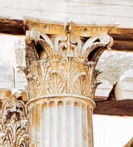
Greek, Corinth, Corinthian capital of an antique
fluted column,
holding a lintel, marble.

Corinthian capital and shaft, with each of its
parts labeled.
Related site:

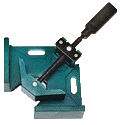 corner clamp - A device which holds together two strips
or slabs of solid material
at right angle while the joint is secured; useful in framing for
example.
corner clamp - A device which holds together two strips
or slabs of solid material
at right angle while the joint is secured; useful in framing for
example.
cornice - The projecting upper section of an entablature. Also any crowning projection.
Examples:
Cornices as they fit into a schematic diagram of the Doric order and into a diagram of the Ionic order.
Also see architrave, classical orders, Corinthian, Doric, frieze, Greek art, Ionic, pediment, raking cornice, and Roman art.
corrugate and corrugated cardboard or
corrugated board - To corrugate is to shape
into undulating folds: parallel or 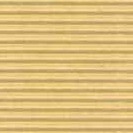
![]() alternating
ridges and grooves. Corrugated cardboard
is a common contemporary material in packaging,
especially for boxes and cartons. It is usually made of three
sheets of paper, the middle one is
corrugated, and laminated between
the other two layers. There are many types of corrugated cardboard,
including colors, shapes
and sizes of the undulations,
and variations in the number of their layers per board. Cut corrugated
cardboard with sturdy razors and light saws. Join pieces with
any of many kinds of adhesives,
staples, and tapes. Objects
made with this material may not be very permanent,
but they're easily and inexpensively produced! Packaging manufacturers
as well as commercial users might even be coaxed into donating
boards to students.
alternating
ridges and grooves. Corrugated cardboard
is a common contemporary material in packaging,
especially for boxes and cartons. It is usually made of three
sheets of paper, the middle one is
corrugated, and laminated between
the other two layers. There are many types of corrugated cardboard,
including colors, shapes
and sizes of the undulations,
and variations in the number of their layers per board. Cut corrugated
cardboard with sturdy razors and light saws. Join pieces with
any of many kinds of adhesives,
staples, and tapes. Objects
made with this material may not be very permanent,
but they're easily and inexpensively produced! Packaging manufacturers
as well as commercial users might even be coaxed into donating
boards to students.
Examples:

Frank O. Gehry (American, born Canada, 1929-),
designe
 r, Easy Edges, c. 1972, side chair, corrugated
cardboard, 33 x 14 1/2 x 23 inches, Minneapolis Institute of
Arts.
r, Easy Edges, c. 1972, side chair, corrugated
cardboard, 33 x 14 1/2 x 23 inches, Minneapolis Institute of
Arts.
A detail of this chair's back reveals the textural qualities produced by the laminated sheets of corrugated cardboard of which Easy Edges is constructed. See architect, design, and furniture.

Frank O. Gehry, designer, manufacturer: New
City Editions, USA, Bubbles Chaise Longue, 1987, corrugated
cardboard with fire-retardant coating, 35 inches x 28 1/2 inches
x 6 feet 1 inches (88.9 x 72.4 x 185.4 cm), Museum of Modern
Art, NY.
Also see dado, design, foam core, graphic design, kerf, and texture.
Cor-ten steel - Cor-ten Steel is a type of steel that oxidizes naturally over time, giving it an orange-brown color and a rough texture. It has a very high tensile strength, and in spite of its rusted appearance it is actually more resistant to damaging corrosion than standard forms of carbon steel. It has been used by many contemporary sculptors and architects. United States Steel Corporation says "COR-TEN® is a registered trademark of United States Steel Corporation and can only be used for products produced by United States Steel Corporation or its licensees. COR-TEN® Steel has proven to be an excellent product for bridges, primary structural framing and sculpture."
Examples:
Claes Oldenburg (American, born Sweden, 1929-) and Coosje van Bruggen (American, born Netherlands, 1942-), Clothespin, 1976, Cor-ten and stainless steels, 45 feet x 12 feet 3 inches x 4 feet 6 inches (13.7 x 3.7 x 1.4 m), Centre Square Plaza, Fifteenth and Market streets, Philadelphia. See Pop Art.
Richard Serra (American, 1939-), Five Plates, Two Poles, 1971, Cor-ten steel, 96 x 276 x 216 inches, Walker Art Center, Minneapolis, MN. See Minimalism.

![]()

Richard Serra, Tilted Arc, 1981, Cor-ten steel, 12 x 120 feet, New York City. See arc.
corundum - A very hard mineral, crystallized allumina or aluminum oxide, used as an abrasive and polish.
Also see carborundum, emery, garnet, and rouge.
cosmetic, cosmeticize, and cosmetize - A cosmetic can be a preparation, such as a powder or cream applied to the skin as makeup, usually intended to beautify the human body, especially the face. Common examples are lipstick, rouge, eyeliner, and mascara. Cosmetics have also been used to disguise or in some other way to change the appearance of an actor or another type of performer. Examples of theatrical cosmetics include pancakes and greasepaints. "Cosmetic" is also used to refer to something artificial that is used to cover a deficit, defect, or irregularity; making something unpleasant or ugly superficially attractive. "Cosmeticize" is a verb form that first appeared in print in the early 19th century. Originally, its use was often literal, with the meaning "to apply a cosmetic to," but today it is usually used figuratively. Some usage commentators have opposed the legitimacy of "cosmeticize", irritated by the proliferation of verbs coined using "-ize". So many such formations are silly, one-time words. However, "cosmeticize" is fairly well-established in contrast with the two other, rarer verbs that have been derived from "cosmetic": "cosmetize," which often turns up in the literal sense that has been mostly lost from "cosmeticize" ("cosmetize the face"), and "cosmetic," which can be literal or figurative ("cosmeticked with bright rouge"; "embellished and cosmeticked").
(pr. kahz-MEH-tək, kahz-MEH-tə-size, and KAHZ-mə-tize)
Example:

Moltrasio (Italian graphic designer) for Paglieri Velluto di Hollywood (cosmetic manufacturer), Woman with Powder Compact, 1950s, poster, offset lithography, 12 x 8 1/2 inches. See advertisement and gaze.
Also see aesthetic, aesthetician, beauty parlor or beauty salon, disfigure, feminism and feminist art, kohl, performance art, stain removal, theater, and pyxis.
cosmononplusation - The vague, speechless awe one experiences upon gazing up into the cosmos and contemplating the pathetic minuteness of one's being. This word was coined by Charles Harrington Elster. (New York Times Magazine, August 29, 1999, page 18.)
coulage - A method of making a sculptural automatism in which one pours a molten material, such as a metal, chocolate, or wax, into cold water. As the material cools it forms a kind of randomized if not entirely accidental form.
Also see aleatory and aleatoric, bricolage, collage, découpage, femmage, frottage, fumage, marouflage, montage, parsemage, and photomontage.
Council for Art Education, Inc. (CFAE) - See Youth Art Month (YAM).
counterculture - A culture, especially of young people, with antiestablishment attitudes, principles or lifestyles.
Also see popular culture.
countermodel - An intermodel. See indirect casting.
counterpoint - A parallel but contrasting element or theme in a design. Incorporating one or more counterpoints in producing an artwork is among the possible means to achieving emphasis.
Also see anomaly, butt, compare, incongruity, irony, juxtaposition, and point.
counterpoise - A counterbalancing weight or force.
Also see balance, cantilever, equilibrium, equipoise.
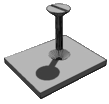
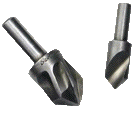
countersink and countersinking - A countersink is a tool with which a drilled hole's opening can be beveled in order to position the head of a screw or a bolt, used to join sections of a work, even with a material's outer surface. Countersinking is the method of using a countersink to do this.
course - When it does not refer to movement or to a portion of a curriculum, it may refer to a continuous layer of a building material, such as brick or tile on a wall or roof of a building. Do not confuse it with coarse, which is identically pronounced.
(pr. kohrs)
Also see clamp, dowel, and masonry.
couture - The profession of designing, making, and selling highly fashionable, usually custom-made clothing — costume. Also, such people considered as a group, or their productions.
(pr. koo-TOOR)
Also see couturier, fashion, and textile.
couturier - An establishment engaged in couture. Such an establishment may be referred to as a house. Also, one who designs for such an establishment.
(pr. koo-TOO-ree-əy)
Also see art careers, costume, fashion, and textile.
cover - The capacity of a pigment to obscure an underlying surface; or, its hiding power. Alternatively, its capacity to extend by given volume over a surface.
https://inform.quest/_art